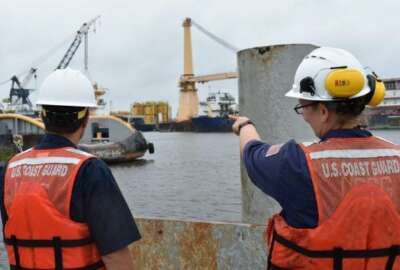Coast Guard turns to tech while facing workforce challenges
Coast Guard Commandant Linda Fagan said that service’s people are its most valuable asset, so it must take care of them.
Short by thousands of personnel, the Coast Guard is turning to technology to help it work more effectively and recruit.
The Coast Guard is using technology for some of its activities like stopping illegal fishing and maritime border control, while also using it to help in its recruitment and workforce efforts.
Illegal, unreported and unregulated (IUU) fishing is a global problem that the Coast Guard is using artificial intelligence to combat. Adm. Linda Fagan, the Coast Guard commandant said the service uses partnerships and agreements to also counter this problem. Technology can help the Coast Guard in several ways with IUU fishing. Specifically, it will utilize open-source information and AI.
“There’s actually quite a bit of information just open-source that needs to be brought together, aligned, analyzed, illuminating the patterns of behavior that demonstrate there’s illegal fishing going on, or fish trans-shipment at sea,” Fagan said at an event hosted by the Center for Strategic and International Studies. “When you are able to generate a ship with the people and the authorities and the expertise, that ship goes right out to the point where the illegal activity is occurring, so that you can utilize your most precious resources in the most effective way.”
The Coast Guard is also implementing biometrics on its ships to help with maritime border patrol. Fagan said the service branch implemented this at the beginning of the year when there were lots of migrants in the Florida Keys as part of an effort to save human life from these challenging journeys.
Fagan said the Coast Guard added biometric tools on its cutters “so that we can ensure that as we encounter someone at sea, that we know who it is, so that either you’ve got clear identity, but then also should you encounter them again, there’s consequence and understanding that this is somebody that’s made a second attempt,” Fagan said. “It’s work that we do in support of the other operating agencies within DHS, and we remain committed to really preventing or minimizing the chance of loss of life at sea.”
The service is also using technology to help with its recruitment efforts. The Coast Guard has faced an ongoing workforce shortage, which was exacerbated by the COVID-19 pandemic.
“If we don’t address the people aspects of the organization, it does become existential,” Fagan said. “These great new cutters, boats, assets, using technology to enforce illegal fishing, that doesn’t happen if you don’t have the human being. We have to have people; they truly are our most valuable asset.”
While recruiting numbers have gotten better, they still have a long way to go, according to Fagan. She added that there’s a race for talent.
“I need people with a propensity to serve that are drawn to the missions of the Coast Guard,” Fagan said.
To address the workforce challenge, the Coast Guard is hiring recruiters and opening more recruiting offices, improving how it leverages technology and using targeted marketing.
“There was a time where we sponsored a NASCAR,” she said. “There was another time where we might have done a big splashy ad as part of the Super Bowl. Now, we’re going to Twitch, it’s an online collaborative gaming site; (we’re) going to where young people are to help excite them and entice them to join us.”
The Coast Guard is also looking to improve its talent management. She said the service was looking to see where it had flexibility and does not need to be as rigid.
The service is looking to make being out at sea easier for its employees. She said while the ship crews love being out at sea, the service wants to make it easier for them while there.
“We’ve done two things that make it that much easier. Starlink (is) increasing people’s capacity to be able to stay in touch with their families and not be so disconnected while they’re at sea,” she said. “That has contributed significantly to morale feeling connected when we’ve got a ship on a major deployment.”
Additionally, the Coast Guard is making the work when a ship gets back from sea easier for its workers. Fagan said that crews have said that the stress comes from the ship maintenance once ashore in part because of the lack of time. Fagan said the service is working to make going out to sea more sustainable for its workforce and to draw people out into its mission. She said they’re working on new opportunities for service members too, such as policy and program work at headquarters so they have cycles ashore too.
“We’re doing some innovative work with the way we’re managing our cooks,” Fagan said. “You can’t send a ship to sea if you don’t have cooks. You need engineers and a few other people, but the cooks really become the heart of the ship. And for example, (a ship) might be short a cook, we can cycle them so that they’re assigned to shore, but have an opportunity to rotate at sea. We’re getting some really great feedback and dividends from that. So, it’s a different approach for how you create meaning and opportunity. And then providing access to interesting port calls; sailors for centuries have loved having the opportunity to see the world and it’s great to be able to provide that opportunity as well.”
Copyright © 2025 Federal News Network. All rights reserved. This website is not intended for users located within the European Economic Area.
Kirsten Errick covers the Defense Department for Federal News Network. She previously reported on federal technology for Nextgov on topics ranging from space to the federal tech workforce. She has a Master’s in Journalism from Georgetown University and a B.A. in Communication from Villanova University.
Follow @kerrickWFED






